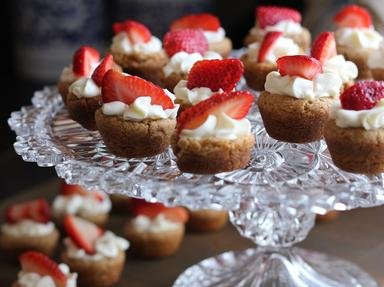Quiz Answer Key and Fun Facts
1. She is famed for what may be an apocryphal line in a recipe for jugged hare - "first catch your hare" - but the English writer of the 1747 cookbook "The Art of Cookery Made Plain & Easy" also included a delicious "apple pye" recipe, made with puff pastry. What was her name?
2. America's original first lady, Martha Dandridge Custis Washington, brought to the Presidential table a huge collection of "receipts"(recipes). In addition to veal, suet, raisins, apples, citrus fruit, spices, etc. her "receipt" for one pie includes "some rosewater, [and] a quarter of a pinte o[f] muskadine or sack" (wine or sherry). What kind of pie would this be, traditionally served at Christmastime?
3. What kind of traditional American pie in the southern United States, spicy and brownish-orange in color, makes the singer "shut my mouth" in Alabama's "Song of the South" by Bob McDill?
4. The Pub Pie Champion recipe for British Pie Week in 2012 included juniper berries, gin, parsnips, and a variety of game birds traditionally hunted by the royal family at their Sandringham estate on Boxing Day (December 26) every year. What birds went into this winning pie recipe?
5. A verse of the folk song "Charming Billy" asks if the wife Billy seeks can bake a particular sort of pie, and Billy answers that indeed she can - "quick as a cat can wink his eye" - -but "she's a young thing and cannot leave her mother." What kind of pie does the "young thing" bake, made from the red fruit of a tree that has been cultivated since ancient times in diverse parts of the world?
6. What small savory pie was originally cooked for tin miners in South West England who needed a filling, easily held workman's lunch that could be eaten in the mines?
7. Recipes for pie pastry usually call for sifted flour; salt; and butter, lard, or another type of fat. The solid fat (in small pieces) is mixed into the flour and salt, then the baker sprinkles water into the mixture, lightly "cutting in" the ingredients with a knife or a fork until they are of the right consistency. What is important about the temperature of the water?
8. Often served in the deep south, what sweet custard pie made with nuts is claimed by some to have been invented in New Orleans in the early days of French settlement but more likely was developed as a promotion by a commercial manufacturer of corn syrup in the early 20th century?
9. The Pilgrims introduced Native American tribes to fresh baked pumpkin pie in fine puff pastry at the very first Thanksgiving in Plymouth, Massachusetts.
10. The origin of the phrase "eating humble pie" - when a proud person comes to public shame and must acknowlege wrongdoings and ask forgiveness - derives from "umble pie", an actual dish prepared by common folk in Medieval England for their own tables. What exactly are the "umbles" from which umble pie is made?
Source: Author
nannywoo
This quiz was reviewed by FunTrivia editor
WesleyCrusher before going online.
Any errors found in FunTrivia content are routinely corrected through our feedback system.
